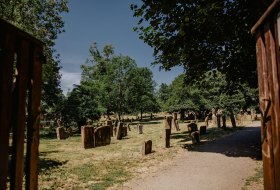
searchMenu


The exhibitons from the series 'Art in the Burggrafiat' take place in regular changes and show artwork of all kinds.

From 1904, Frei-Weinheim had a railway connection for goods and passenger traffic for exactly 50 years. The former train station building in Heimat style is still preserved. The single-track Selztalbahn connected the Rheinhessen hinterland from Jugenheim-Partenheim to the port in Frei-Weinheim. In Nieder-Ingelheim, there was a connection to the left bank Ludwigsbahn, which had been running between Mainz and Bingen since 1859. Since the Selztalbahn was primarily used for the transport of sugar beets, it was nicknamed…

In July 2021, the cities of Worms, Speyer and Mainz were awarded the title of World Heritage Site by UNESCO for their ShUM sites. The cities are considered the cradle of Ashkenazi Judaism. Discover the Jewish monuments in Worms and their significance for the cultural heritage on this guided tour. You will visit the oldest preserved Jewish cemetery in situ in Europe, the ‘Holy Sand’, as well as the former Jewish quarter in the Judengasse with the synagogue. The monuments illustrate Jewish life in the city and, together with the…

The foundation is intended to preserve and cultivate the life's work of the sculptor Eberhard Linke, to make his works accessible to the public, to make them scientifically accessible and to place them in the history of art. At the same time, the Foundation promotes younger artists and offers working stays and courses in the Foundation's premises in Flonheim for the hollow construction of terracotta sculptures. The studio regularly hosts concerts, readings, film screenings and lectures.

Even today, the Neustadt owes its architectural and urban face to the city master builder Eduard Kreyßig (1830-1897), despite being heavily affected by the destruction of World War II. Many of the Gründerzeit residential buildings with partly magnificent facades, as well as the prominently visible Christ Church, are still preserved. In particular, in recent years, it has been possible to carefully renovate the Neustadt. Modern architects and artists have contributed to the appearance of the Neustadt with their buildings and…

Every week on Tuesday, Friday, and Saturday from 7 AM to 2 PM, the cathedral squares in Mainz transform into a colorful market scene. The Mainz weekly market is one of the most beautiful weekly markets in Germany and invites you to shop in a special atmosphere, stroll around, and enjoy the regional diversity. Here you will find a large selection of fresh foods and specialties: from crunchy vegetables and fruits from the region to delicious delicacies, bread, cheese, and meats. During the peak season, 20-30 daily stalls complement the…

The neighbouring earlier Hessen Amtsgericht is a neo baroque complex, whose 3 wings encase a courtyard open to the south. This palace-like estate was built between 1907 and 1909, according to plans of the Hessisches Hochbauamt Darmstadt. The facade of the main building is dominated by a triangular gable. An open stair leds to an admirably rounded portal guarded by pillars above which a coat of arms with the inscription “Hessisches Amtsgericht” is preserved. At the end of the 20th century these premises were sold by the state…

A staircase leads up to the viewing platform. From here, you can enjoy a wonderful view of the hilly vineyard landscape.